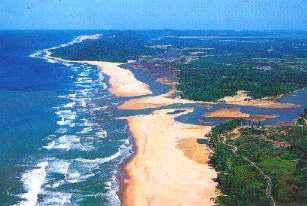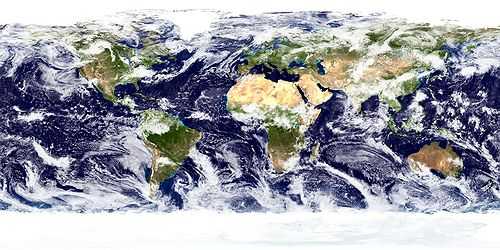Limnology
Limnology (/lɪmˈnɒlədʒi/ lim-NOL-ə-jee; from Greek λίμνη, limne, "lake" and λόγος, logos, "knowledge"), is the study of inland waters. It is often regarded as a division of ecology or environmental science. It covers the biological, chemical, physical, geological, and other attributes of all inland waters (running and standing waters, both fresh and saline, natural or man-made). This includes the study of lakes and ponds, rivers, springs, streams and wetlands.[1] A more recent sub-discipline of limnology, termed landscape limnology, studies, manages, and conserves these aquatic ecosystems using a landscape perspective.
Limnology is closely related to aquatic ecology and hydrobiology, which study aquatic organisms in particular regard to their hydrological environment. Although limnology is sometimes equated with freshwater science, this is erroneous since limnology also comprises the study of inland salt lakes.
History
The term limnology was coined by François-Alphonse Forel (1841–1912) who established the field with his studies of Lake Geneva. Interest in the discipline rapidly expanded, and in 1922 August Thienemann (a German zoologist) and Einar Naumann (a Swedish botanist) co-founded the International Society of Limnology (SIL, from Societas Internationalis Limnologiae). Forel's original definition of limnology, "the oceanography of lakes", was expanded to encompass the study of all inland waters,[1] and influenced Benedykt Dybowski's work on Lake Baikal.
Prominent early American limnologists included G. Evelyn Hutchinson, Ed Deevey, E. A. Birge, and C. Juday.[2]
Lake classification

Limnology classifies lakes (or other bodies of water) according to the trophic state index.[1] An oligotrophic lake is characterised by relatively low levels of primary production and low levels of nutrients. A eutrophic lake has high levels of primary productivity due to very high nutrient levels. Eutrophication of a lake can lead to algal blooms. Dystrophic lakes have high levels of humic matter and typically has yellow-brown, tea-coloured waters.[1] These categories do not have rigid specifications; the classification system can be seen as more of a spectrum encompassing the various levels of aquatic productivity.
Organizations
- Association for the Sciences of Limnology and Oceanography
- Asociación Ibérica de Limnología
- Australian Society for Limnology
- Society of Canadian Limnologists
- European Society of Limnology and Oceanography
- Society of Limnology
- Italian Association for Oceanology and Limnology (AIOL)
- The Japanese Society of Limnology
- International Society of Limnology
- Brazilian Society of Limnology
- New Zealand freshwater Sciences society
- Southern African Society of Aquatic Scientists
- Balaton Limnological Research Institute
- Polish Limnological Society
- Society for Freshwater Science (formerly North American Benthological Society)
- Czech Limnological Society
- Freshwater Biological Association (UK)
Journals
- Advances in Limnology
- Annales de Limnologie - International Journal of Limnology
- Aquatic Conservation
- Aquatic Ecology
- Canadian Journal of Fisheries and Aquatic Sciences
- Chinese Journal of Oceanology and Limnology
- Freshwater Biology
- Hydrobiologia
- Journal of Ecology and Fisheries
- Journal of Limnology
- Limnetica
- Limnologica
- Limnological Review
- Journal of the North American Benthological Society
- Limnology and Oceanography
- Marine and Freshwater Research
- New Zealand Journal of Marine and Freshwater Research
- Review of Hydrobiology
- River Research and Applications
See also
- Freshwater biology
- Hydrology
- Lake aeration
- Lentic ecosystems
- Limnic eruption
- Lotic ecosystems
- Marine biology
- Paleolimnology
- Vernal pool
Notes
References
- Gerald A. Cole, Textbook of Limnology, 4th ed. (Waveland Press, 1994) ISBN 0-88133-800-1
- Stanley Dodson, Introduction to Limnology (2005), ISBN 0-07-287935-1
- A.J.Horne and C.R. Goldman: Limnology (1994), ISBN 0-07-023673-9
- G. E. Hutchinson, A Treatise on Limnology, 3 vols. (1957–1975) - classic but dated
- H.B.N. Hynes, The Ecology of Running Waters (1970)
- Jacob Kalff, Limnology (Prentice Hall, 2001)
- B. Moss, Ecology of Fresh Waters (Blackwell, 1998)
- Robert G. Wetzel and Gene E. Likens, Limnological Analyses, 3rd ed. (Springer-Verlag, 2000)
- Patrick E. O'Sullivan and Colin S. Reynolds The Lakes Handbook: Limnology and limnetic ecology ISBN 0-632-04797-6
External links
| Look up limnology in Wiktionary, the free dictionary. |
- The History of Limnology at the University of Wisconsin–Madison: A digital resource documenting three generations of limnological research in Wisconsin. Much of the collection comes from the archives of the UW–Madison Center for Limnology. It focuses on three important pioneers of limnology, Dr. Edward A. Birge, Chancey Juday and Arthur D. Hasler, as well as Wisconsin research laboratories and field equipment. Presented by the University of Wisconsin Digital Collections Center.
- Breaking new waters: a Century of Limnology at the University of Wisconsin: A special publication of the Wisconsin Academy of Sciences, Arts and Letters in celebration of a century of limnological research.
- Limnological Institute of the Siberian Division of the Russian Academy of Sciences
| ||||||||



